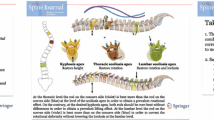Abstract
Background
Correcting the scoliosis and stabilizing the spine in the corrected position is the basis of treatment for adolescent idiopathic scoliosis (AIS). Spinal instrumentation and derotation are the principle steps of surgery for any type of AIS. A perspicuous understanding needs to be attained regarding derotation maneuvers in practice; therefore, we intend to compare radiological outcomes following concave and convex rod derotation maneuvers to analyze their efficacy to correct selective Lenke’s Type-1 scoliosis
Materials and Methods
Retrospectively, 88 patients with Lenke’s Type-1 scoliosis who were operated with selective thoracic instrumentation were divided into two groups depending on the derotation side. Preoperative radiographs were analyzed for curve angles, thoracic apical vertebral translation, apical vertebral rotation, and coronal/sagittal balance. Postoperative and followup assessment was focused on curve correction. Correction rate of main thoracic (MT) curve and its corresponding loss of correction at final followup are calculated
Results
Concave group (n = 40; age 13.8 ± 1.9) and the convex group (n = 48; Age 14.3 ± 2.4) showed similar demographic characteristics. Postoperative and followup parameters showed no significant difference. Correction rate of MT curve between both groups (concave group = 69.2 ± 10.5%; convex group = 66 ± 12.8%; P = 0.20) was similar. There was minimal loss of correction at final followup among both groups (concave group = 2.2º ±5.4º; Convex group = 1.5º ± 4.8º; P = 0.52)
Conclusion
The study results showed similar sustained satisfactory correction of flexible Lenke’s type 1 scoliotic curves irrespective of the derotation maneuver used. Adequate correction, thereby restoring balance was predominantly perceived among the entire sample. Hence, convex derotation can be considered equally effective as that of concave derotation for achieving adequate correction of selective Lenke’s Type-1 scoliosis
Similar content being viewed by others
References
Hasler CC. A brief overview of 100 years of history of surgical treatment for adolescent idiopathic scoliosis. J Child Orthop 2013;7:57–62.
Kim JY, Song K, Kim KH, Rim DC, Yoon SH. Usefulness of simple rod rotation to correct curve of adolescent idiopathic scoliosis. J Korean Neurosurg Soc 2015;58:534–8.
Anekstein Y, Mirovsky Y, Arnabitsky V, Gelfer Y, Zaltz I, Smorgick Y, et al. Reversing the concept: Correction of adolescent idiopathic scoliosis using the convex rod de-rotation maneuver. Eur Spine J 2012;21:1942–9.
Ito M, Abumi K, Kotani Y, Takahata M, Sudo H, Hojo Y, et al. Simultaneous double-rod rotation technique in posterior instrumentation surgery for correction of adolescent idiopathic scoliosis. J Neurosurg Spine 2010;12:293–300.
Remes V, Helenius I, Schlenzka D, Yrjönen T, Ylikoski M, Poussa M, et al. Cotrel-dubousset (CD) or universal spine system (USS) instrumentation in adolescent idiopathic scoliosis (AIS): Comparison of midterm clinical, functional, and radiologic outcomes. Spine (Phila Pa 1976) 2004;29:2024–30.
Shah SA. Derotation of the spine. Neurosurg Clin N Am 2007;18:339–45.
Suk SI. Pedicle screw instrumentation for adolescent idiopathic scoliosis: The insertion technique, the fusion levels and direct vertebral rotation. Clin Orthop Surg 2011;3:89–100.
Sud A, Tsirikos AI. Current concepts and controversies on adolescent idiopathic scoliosis: Part II. Indian J Orthop 2013;47:219–29.
Wu X, Yang S, Xu W, Yang C, Ye S, Liu X, et al. Comparative intermediate and long term results of pedicle screw and hook instrumentation in posterior correction and fusion of idiopathic thoracic scoliosis. J Spinal Disord Tech 2010;23:467–73.
Yilmaz G, Borkhuu B, Dhawale AA, Oto M, Littleton AG, Mason DE, et al. Comparative analysis of hook, hybrid, and pedicle screw instrumentation in the posterior treatment of adolescent idiopathic scoliosis. J Pediatr Orthop 2012;32:490–9.
Lenke LG, Betz RR, Clements D, Merola A, Haher T, Lowe T, et al. Curve prevalence of a new classification of operative adolescent idiopathic scoliosis: Does classification correlate with treatment? Spine (Phila Pa 1976) 2002;27:604–11.
Ogon M, Giesinger K, Behensky H, Wimmer C, Nogler M, Bach CM, et al. Interobserver and intraobserver reliability of lenke’s new scoliosis classification system. Spine (Phila Pa 1976) 2002;27:858–62.
Lam GC, Hill DL, Le LH, Raso JV, Lou EH. Vertebral rotation measurement: A summary and comparison of common radiographic and CT methods. Scoliosis 2008;3:16.
Nash CL Jr., Moe JH. A study of vertebral rotation. J Bone Joint Surg Am 1969;51:223–9.
Kim YJ, Lenke LG, Cho SK, Bridwell KH, Sides B, Blanke K, et al. Comparative analysis of pedicle screw versus hook instrumentation in posterior spinal fusion of adolescent idiopathic scoliosis. Spine (Phila Pa 1976) 2004;29:2040–8.
Liljenqvist U, Hackenberg L, Link T, Halm H. Pullout strength of pedicle screws versus pedicle and laminar hooks in the thoracic spine. Acta Orthop Belg 2001;67:157–63.
Terai H, Toyoda H, Suzuki A, Dozono S, Yasuda H, Tamai K, et al. A new corrective technique for adolescent idiopathic scoliosis: Convex manipulation using 6.35 mm diameter pure titanium rod followed by concave fixation using 6.35 mm diameter titanium alloy. Scoliosis 2015;10:S14.
Smorgick Y, Millgram MA, Anekstein Y, Floman Y, Mirovsky Y. Accuracy and safety of thoracic pedicle screw placement in spinal deformities. J Spinal Disord Tech 2005;18:522–6.
Wang S, Qiu Y, Liu W, Shi B, Wang B, Yu Y, et al. The potential risk of spinal cord injury from pedicle screw at the apex of adolescent idiopathic thoracic scoliosis: Magnetic resonance imaging evaluation. BMC Musculoskelet Disord 2015;16:310.
Uçar BY. A new corrective technique for adolescent idiopathic scoliosis (Ucar’s convex rod rotation). J Craniovertebr Junction Spine 2014;5:114–7.
Author information
Authors and Affiliations
Corresponding author
Rights and permissions
About this article
Cite this article
Kaliya-Perumal, AK., Yeh, YC., Niu, CC. et al. Is Convex Derotation Equally Effective as Concave Derotation for Achieving Adequate Correction of Selective Lenke’s Type- 1 Scoliosis?. IJOO 52, 363–368 (2018). https://doi.org/10.4103/ortho.IJOrtho_447_16
Published:
Issue Date:
DOI: https://doi.org/10.4103/ortho.IJOrtho_447_16




